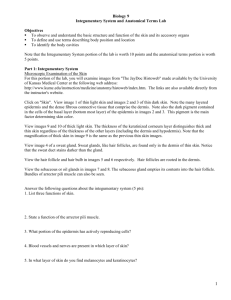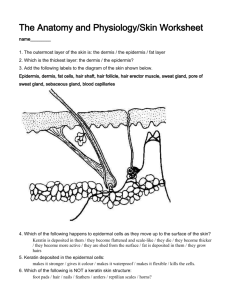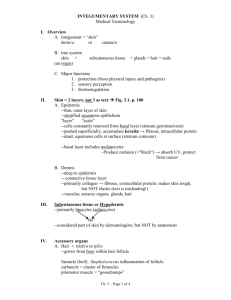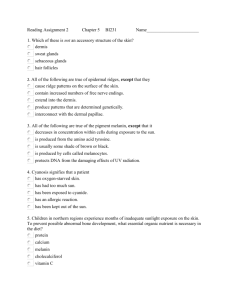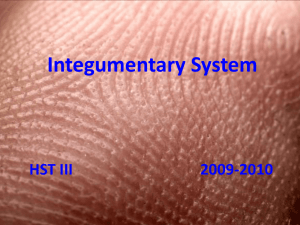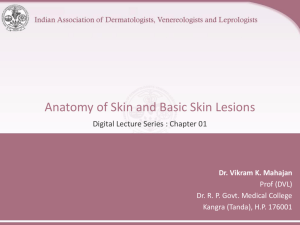Integumentary_System
advertisement
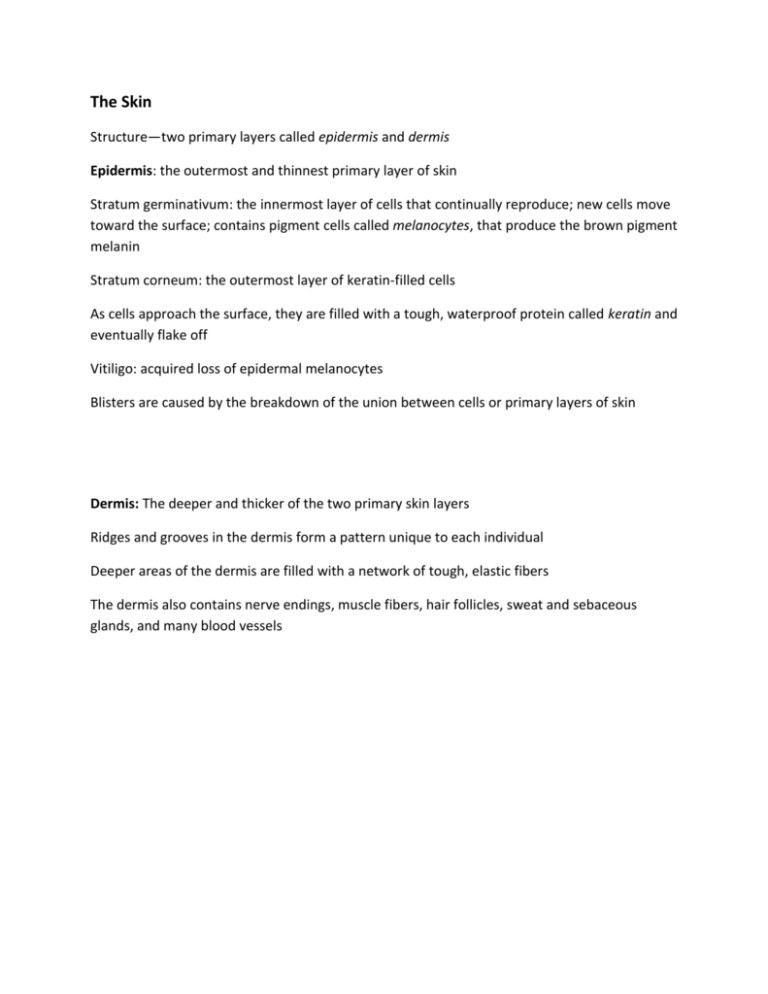
The Skin Structure—two primary layers called epidermis and dermis Epidermis: the outermost and thinnest primary layer of skin Stratum germinativum: the innermost layer of cells that continually reproduce; new cells move toward the surface; contains pigment cells called melanocytes, that produce the brown pigment melanin Stratum corneum: the outermost layer of keratin-filled cells As cells approach the surface, they are filled with a tough, waterproof protein called keratin and eventually flake off Vitiligo: acquired loss of epidermal melanocytes Blisters are caused by the breakdown of the union between cells or primary layers of skin Dermis: The deeper and thicker of the two primary skin layers Ridges and grooves in the dermis form a pattern unique to each individual Deeper areas of the dermis are filled with a network of tough, elastic fibers The dermis also contains nerve endings, muscle fibers, hair follicles, sweat and sebaceous glands, and many blood vessels Appendages of the skin Hair The soft hair of the fetus and newborn is called lanugo Hair growth requires an epidermal tube-like structure called the hair follicle Hair growth begins from hair papilla The hair root lies hidden in the follicle; the visible part of hair is called the shaft Arrector pili: specialized smooth muscle that produces “goose bumps” and causes hair to stand up straight Receptors Specialized nerve endings that make it possible for skin to act as a sense organ Meissner’s corpuscle is capable of detecting light touch The Pacinian corpuscle is capable of detecting pressure Nails Produced by epidermal cells over terminal ends of fingers and toes The visible part is called the nail body The root lies in a groove and is hidden by the cuticle The crescent-shaped area nearest the root is called the lunula The nail bed may change color with changes in blood flow (oxygenation) Skin glands Eccrine sweat glands The most numerous, important, and widespread of the sweat glands Produce perspiration which flows out through pores on skin surface Function throughout life and assist in body heat regulation Apocrine sweat glands Found primarily under the arms and around genitalia Secrete a thicker, milky secretion quite different from eccrine perspiration Breakdown of secretions by skin bacteria produces odor Sebaceous glands Secrete oil for hair and skin The level of secretion increases during adolescence The amount of secretion is regulated by sex hormones Sebum in sebaceous gland ducts may darken to form blackheads Acne vulgaris involves inflammation of the sebaceous gland ducts Functions of the Skin Protection: a first line of defense Against infection by microbes Against ultraviolet rays from sun Against harmful chemicals Against cuts and tears Temperature regulation Skin can release almost 3000 calories of body heat per day Mechanisms of temperature regulation Regulation of sweat secretion Regulation of the flow of blood close to the surface of the skin Sense organ activity Our skin functions as an enormous sense organ Skin receptors serve as receivers for the body, keeping it informed of changes in its environment Skin Lesions Elevated lesions cast a shadow outside their edges Papule: a small, firm raised lesion (e.g. warts) Plaque: a large raised lesion (caused by friction) Vesicle: a small, fluid-filled blister (e.g. non-genital herpes) Pustule: a pus-filled lesion (e.g. acne) Crust: a scab (dried blood and/or exudate) Wheal (hive): a raised, irregularly-shaped, firm lesion with a light center Flat lesions do not cast a shadow Macule: a flat, discolored region (e.g. freckle) Patch: a macule larger than 1cm (e.g. vitiligo) Depressed lesions cast a shadow within their edges Excoriation: a lesion with missing epidermis, as in a scratch wound Atrophy: areas showing loss of tissue (e.g. striae) Ulcer: a craterlike lesion caused by disintegration of the skin (e.g. bedsore) Fissure: a deep crack or break from the epidermis to the dermis (e.g. athlete’s foot) Skin Infections Impetigo is a highly contagious staphylococcal infection Tinea is a fungal infection (mycosis) of the skin; several forms occur Boils (furuncles) are staphylococcal infections of hair follicles Scabies is a parasitic infection (mite) passed through skin-to-skin contact Vascular and Inflammatory Skin Disorders Decubitus ulcers (bedsores) develop when pressure slows down blood flow to local areas of the skin Urticaria (hives) are red lesions caused by fluid loss from blood vessels Scleroderma is a disorder of vessels and connective tissue characterized by hardening of the skin Psoriasis is a chronic inflammatory condition accompanied by scaly plaques Eczema is a common inflammatory condition characterized by papules, vesicles, and crusts; it is not a disease itself but a symptom of an underlying condition Skin Cancer Squamous cell carcinoma is the most common type, characterized by hard, raised tumors; slowgrowing, painless, but likely to metastasize Basal cell carcinoma is typically found on the upper face; it is characterized by papules with a central crater; rarely spreads Melanoma is a malignancy in a nevus (mole); it is the most serious type of skin cancer Skin Cancer The most important causative factor in common skin cancers is exposure to sunlight Kaposi sarcoma, characterized by purple lesions, is associated with AIDS and other immune deficiencies; it may be caused by a virus



